2010 BUICK LACROSSE wheel
[x] Cancel search: wheelPage 361 of 414
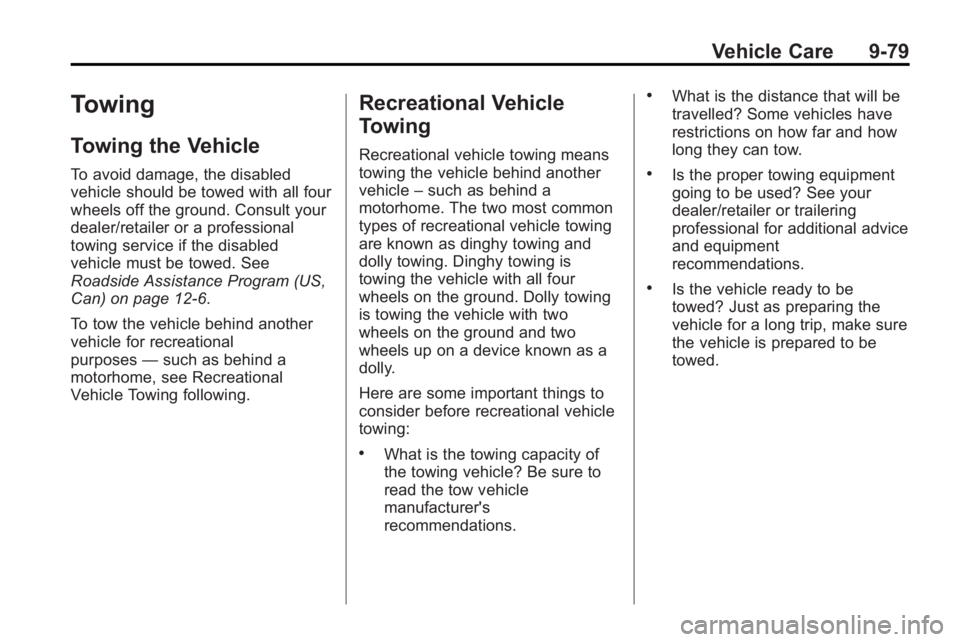
Vehicle Care 9-79
Towing
Towing the Vehicle
To avoid damage, the disabled
vehicle should be towed with all four
wheels off the ground. Consult your
dealer/retailer or a professional
towing service if the disabled
vehicle must be towed. See
Roadside Assistance Program (US,
Can) on page 12‑6.
To tow the vehicle behind another
vehicle for recreational
purposes—such as behind a
motorhome, see Recreational
Vehicle Towing following.
Recreational Vehicle
Towing
Recreational vehicle towing means
towing the vehicle behind another
vehicle –such as behind a
motorhome. The two most common
types of recreational vehicle towing
are known as dinghy towing and
dolly towing. Dinghy towing is
towing the vehicle with all four
wheels on the ground. Dolly towing
is towing the vehicle with two
wheels on the ground and two
wheels up on a device known as a
dolly.
Here are some important things to
consider before recreational vehicle
towing:
.What is the towing capacity of
the towing vehicle? Be sure to
read the tow vehicle
manufacturer's
recommendations.
.What is the distance that will be
travelled? Some vehicles have
restrictions on how far and how
long they can tow.
.Is the proper towing equipment
going to be used? See your
dealer/retailer or trailering
professional for additional advice
and equipment
recommendations.
.Is the vehicle ready to be
towed? Just as preparing the
vehicle for a long trip, make sure
the vehicle is prepared to be
towed.
Page 362 of 414
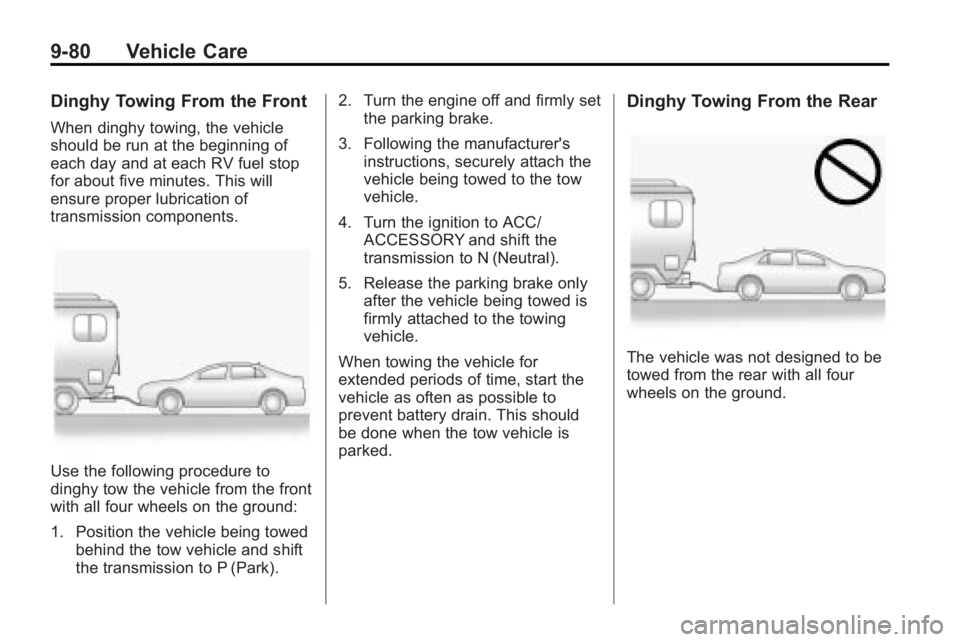
9-80 Vehicle Care
Dinghy Towing From the Front
When dinghy towing, the vehicle
should be run at the beginning of
each day and at each RV fuel stop
for about five minutes. This will
ensure proper lubrication of
transmission components.
Use the following procedure to
dinghy tow the vehicle from the front
with all four wheels on the ground:
1. Position the vehicle being towedbehind the tow vehicle and shift
the transmission to P (Park). 2. Turn the engine off and firmly set
the parking brake.
3. Following the manufacturer's instructions, securely attach the
vehicle being towed to the tow
vehicle.
4. Turn the ignition to ACC/ ACCESSORY and shift the
transmission to N (Neutral).
5. Release the parking brake only after the vehicle being towed is
firmly attached to the towing
vehicle.
When towing the vehicle for
extended periods of time, start the
vehicle as often as possible to
prevent battery drain. This should
be done when the tow vehicle is
parked.
Dinghy Towing From the Rear
The vehicle was not designed to be
towed from the rear with all four
wheels on the ground.
Page 363 of 414
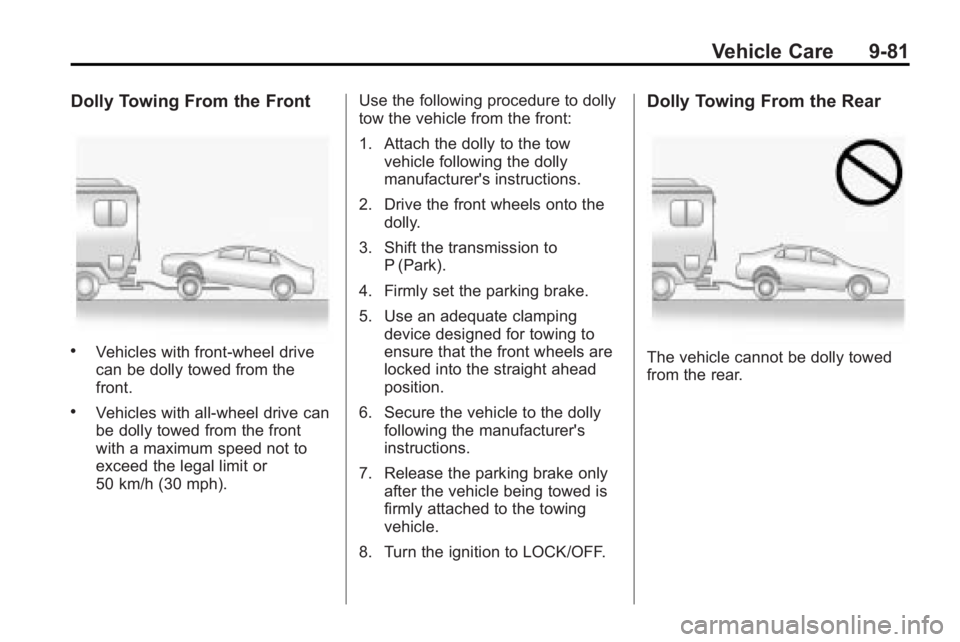
Vehicle Care 9-81
Dolly Towing From the Front
.Vehicles with front-wheel drive
can be dolly towed from the
front.
.Vehicles with all-wheel drive can
be dolly towed from the front
with a maximum speed not to
exceed the legal limit or
50 km/h (30 mph).Use the following procedure to dolly
tow the vehicle from the front:
1. Attach the dolly to the tow
vehicle following the dolly
manufacturer's instructions.
2. Drive the front wheels onto the dolly.
3. Shift the transmission to P (Park).
4. Firmly set the parking brake.
5. Use an adequate clamping device designed for towing to
ensure that the front wheels are
locked into the straight ahead
position.
6. Secure the vehicle to the dolly following the manufacturer's
instructions.
7. Release the parking brake only after the vehicle being towed is
firmly attached to the towing
vehicle.
8. Turn the ignition to LOCK/OFF.
Dolly Towing From the Rear
The vehicle cannot be dolly towed
from the rear.
Page 366 of 414
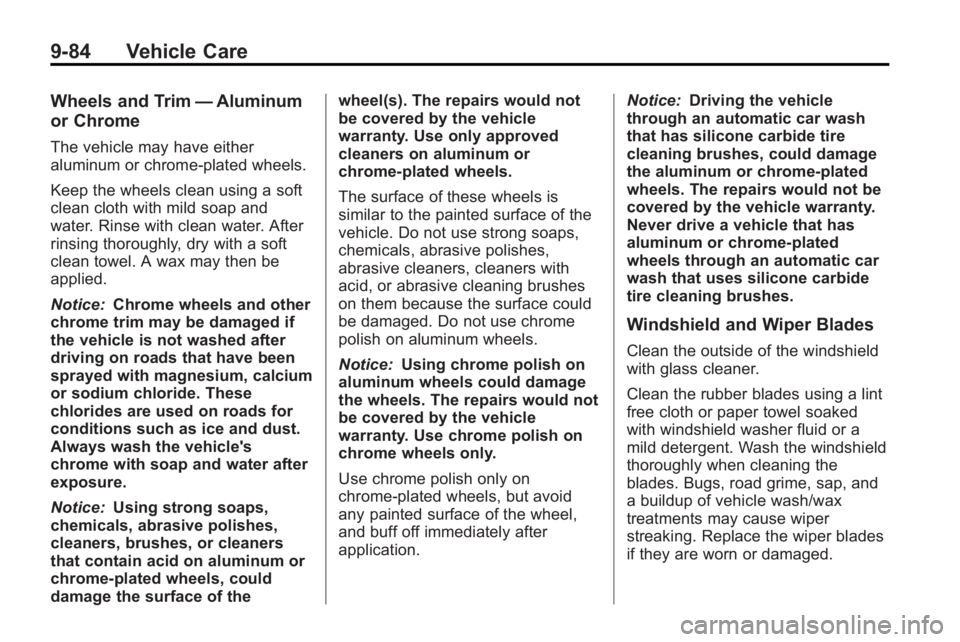
9-84 Vehicle Care
Wheels and Trim—Aluminum
or Chrome
The vehicle may have either
aluminum or chrome-plated wheels.
Keep the wheels clean using a soft
clean cloth with mild soap and
water. Rinse with clean water. After
rinsing thoroughly, dry with a soft
clean towel. A wax may then be
applied.
Notice: Chrome wheels and other
chrome trim may be damaged if
the vehicle is not washed after
driving on roads that have been
sprayed with magnesium, calcium
or sodium chloride. These
chlorides are used on roads for
conditions such as ice and dust.
Always wash the vehicle's
chrome with soap and water after
exposure.
Notice: Using strong soaps,
chemicals, abrasive polishes,
cleaners, brushes, or cleaners
that contain acid on aluminum or
chrome-plated wheels, could
damage the surface of the wheel(s). The repairs would not
be covered by the vehicle
warranty. Use only approved
cleaners on aluminum or
chrome-plated wheels.
The surface of these wheels is
similar to the painted surface of the
vehicle. Do not use strong soaps,
chemicals, abrasive polishes,
abrasive cleaners, cleaners with
acid, or abrasive cleaning brushes
on them because the surface could
be damaged. Do not use chrome
polish on aluminum wheels.
Notice:
Using chrome polish on
aluminum wheels could damage
the wheels. The repairs would not
be covered by the vehicle
warranty. Use chrome polish on
chrome wheels only.
Use chrome polish only on
chrome-plated wheels, but avoid
any painted surface of the wheel,
and buff off immediately after
application. Notice:
Driving the vehicle
through an automatic car wash
that has silicone carbide tire
cleaning brushes, could damage
the aluminum or chrome-plated
wheels. The repairs would not be
covered by the vehicle warranty.
Never drive a vehicle that has
aluminum or chrome-plated
wheels through an automatic car
wash that uses silicone carbide
tire cleaning brushes.
Windshield and Wiper Blades
Clean the outside of the windshield
with glass cleaner.
Clean the rubber blades using a lint
free cloth or paper towel soaked
with windshield washer fluid or a
mild detergent. Wash the windshield
thoroughly when cleaning the
blades. Bugs, road grime, sap, and
a buildup of vehicle wash/wax
treatments may cause wiper
streaking. Replace the wiper blades
if they are worn or damaged.
Page 385 of 414

Technical Data 11-3
ApplicationCapacities
Metric English
Fuel Tank
AWD 74.0 L 19.5 gal
FWD 70.5 L 18.6 gal
Transmission Fluid* (Drain and Refill)
2.4L L4 Engine, 6–Speed Automatic 8.0 L 8.5 qt
3.0L V6 Engine, All Wheel Drive, 6–Speed Automatic 9.0 L 9.5 qt
3.0L V6 Engine, Front Wheel Drive, 6–Speed Automatic 9.0 L 9.5 qt
3.6L V6 Engine, 6–Speed Automatic 9.0 L 9.5 qt
Wheel Nut Torque 150 Y110 ft lb
*See Automatic Transmission Fluid
on page 9‑15for information on checking fluid level.
All capacities are approximate. When adding, be sure to fill to the approximate level, as recommended in this
manual. Recheck fluid level after filling.
Page 391 of 414
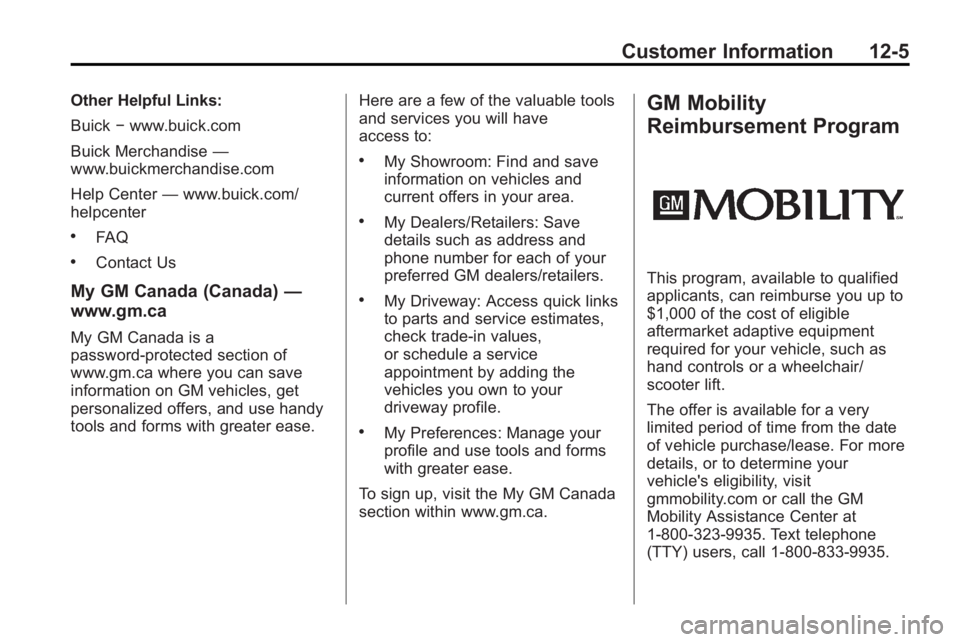
Customer Information 12-5
Other Helpful Links:
Buick−www.buick.com
Buick Merchandise —
www.buickmerchandise.com
Help Center —www.buick.com/
helpcenter
.FAQ
.Contact Us
My GM Canada (Canada) —
www.gm.ca
My GM Canada is a
password-protected section of
www.gm.ca where you can save
information on GM vehicles, get
personalized offers, and use handy
tools and forms with greater ease. Here are a few of the valuable tools
and services you will have
access to:
.My Showroom: Find and save
information on vehicles and
current offers in your area.
.My Dealers/Retailers: Save
details such as address and
phone number for each of your
preferred GM dealers/retailers.
.My Driveway: Access quick links
to parts and service estimates,
check trade-in values,
or schedule a service
appointment by adding the
vehicles you own to your
driveway profile.
.My Preferences: Manage your
profile and use tools and forms
with greater ease.
To sign up, visit the My GM Canada
section within www.gm.ca.
GM Mobility
Reimbursement Program
This program, available to qualified
applicants, can reimburse you up to
$1,000 of the cost of eligible
aftermarket adaptive equipment
required for your vehicle, such as
hand controls or a wheelchair/
scooter lift.
The offer is available for a very
limited period of time from the date
of vehicle purchase/lease. For more
details, or to determine your
vehicle's eligibility, visit
gmmobility.com or call the GM
Mobility Assistance Center at
1-800-323-9935. Text telephone
(TTY) users, call 1-800-833-9935.
Page 403 of 414

INDEX i-1
A
Accessories andModifications . . . . . . . . . . . . . . . . . . 9-3
Accessory Power . . . . . . . . . . . . . . 8-20
Adaptive Forward Lighting (AFL) . . . . . . . . . . . . . . . . . 5-3
Add-On Electrical
Equipment . . . . . . . . . . . . . . . . . . . 8-60
Adding Equipment to the Airbag-Equipped Vehicle . . . . . 2-38
Adjustments
Lumbar, Front Seats . . . . . . . . . . . 2-5
Air Cleaner/Filter, Engine . . . . . . 9-15
Air Filter, Passenger Compartment . . . . . . . . . . . . . . . . . 7-8
Air Intake . . . . . . . . . . . . . . . . . . . . . . . 7-8
Air Vents . . . . . . . . . . . . . . . . . . . . . . . 7-8
Airbag System
Check . . . . . . . . . . . . . . . . . . . . . . . . 2-39
How Does an AirbagRestrain? . . . . . . . . . . . . . . . . . . . 2-30
Passenger Sensing System . . . . . . . . . . . . . . . . . . . . . . 2-32 Airbag System (cont.)
What Makes an Airbag
Inflate? . . . . . . . . . . . . . . . . . . . . . . 2-30
What Will You See After
an Airbag Inflates? . . . . . . . . . . 2-30
When Should an Airbag Inflate? . . . . . . . . . . . . . . . . . . . . . . 2-28
Where Are the Airbags? . . . . . . 2-27
Airbags
Adding Equipment to theVehicle . . . . . . . . . . . . . . . . . . . . . . 2-38
Passenger Status Indicator . . . 4-16
Readiness Light . . . . . . . . . . . . . . 4-16
Servicing Airbag-Equipped Vehicles . . . . . . . . . . . . . . . . . . . . . 2-37
System Check . . . . . . . . . . . . . . . . 2-24
Alarm System Anti-Theft . . . . . . . . . . . . . . . . . . . . . 1-13
All-Wheel Drive . . . . . . . . . . . . . . . . 8-30
AM-FM Radio . . . . . . . . . . . . . . . . . . 6-12
Antenna Satellite Radio . . . . . . . . . . . . . . . . 6-19
Anti-Theft
Alarm System . . . . . . . . . . . . . . . . 1-13
Alarm System Messages . . . . . 4-37 Antilock Brake
System (ABS) . . . . . . . . . . . . . . . . 8-31
Warning Light . . . . . . . . . . . . . . . . . 4-21
Appearance Care Exterior . . . . . . . . . . . . . . . . . . . . . . . 9-82
Interior . . . . . . . . . . . . . . . . . . . . . . . . 9-86
Assistance Program,
Roadside . . . . . . . . . . . . . . . . . . . . . 12-6
Audio Players . . . . . . . . . . . . . . . . . 6-20 CD . . . . . . . . . . . . . . . . . . . . . . . . . . . 6-20
Audio System
Backglass Antenna . . . . . . . . . . . 6-19
Radio Reception . . . . . . . . . . . . . . 6-18
Theft-Deterrent Feature . . . . . . . . 6-2
Automatic Headlamp System . . . . . . . . . . . . . 5-3
Automatic Climate Control System . . . . . . . . . . . . . . . . . . . . . . . . 7-1
Automatic Transmission . . . . . . . 8-27 Fluid . . . . . . . . . . . . . . . . . . . . . . . . . . 9-15
Manual Mode . . . . . . . . . . . . . . . . . 8-29
Shiftlock Control SystemCheck . . . . . . . . . . . . . . . . . . . . . . . 9-27
Auxiliary Devices . . . . . . . . 6-28, 6-31
Page 405 of 414
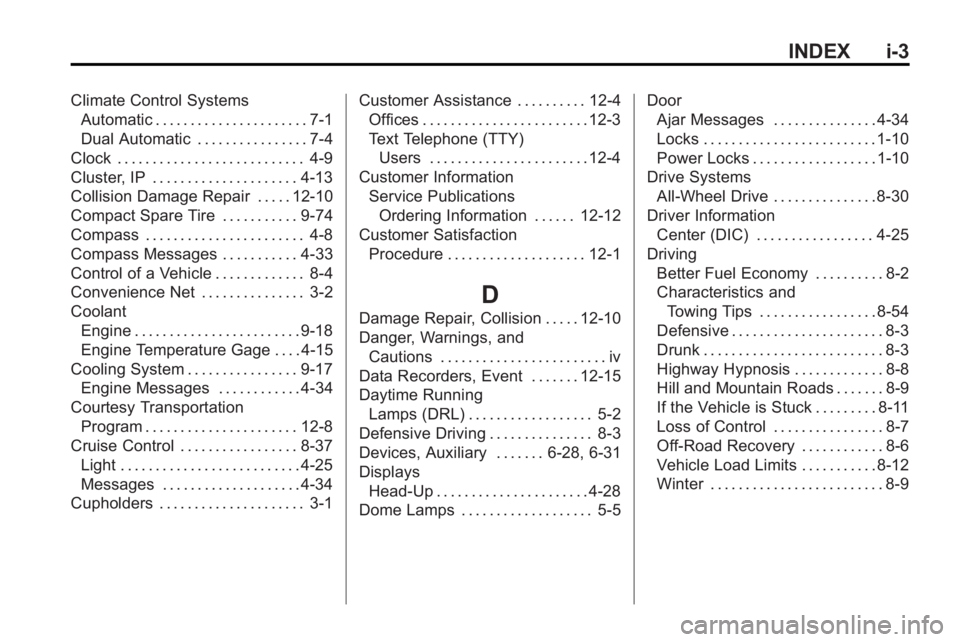
INDEX i-3
Climate Control SystemsAutomatic . . . . . . . . . . . . . . . . . . . . . . 7-1
Dual Automatic . . . . . . . . . . . . . . . . 7-4
Clock . . . . . . . . . . . . . . . . . . . . . . . . . . . 4-9
Cluster, IP . . . . . . . . . . . . . . . . . . . . . 4-13
Collision Damage Repair . . . . . 12-10
Compact Spare Tire . . . . . . . . . . . 9-74
Compass . . . . . . . . . . . . . . . . . . . . . . . 4-8
Compass Messages . . . . . . . . . . . 4-33
Control of a Vehicle . . . . . . . . . . . . . 8-4
Convenience Net . . . . . . . . . . . . . . . 3-2
Coolant Engine . . . . . . . . . . . . . . . . . . . . . . . . 9-18
Engine Temperature Gage . . . . 4-15
Cooling System . . . . . . . . . . . . . . . . 9-17 Engine Messages . . . . . . . . . . . . 4-34
Courtesy Transportation Program . . . . . . . . . . . . . . . . . . . . . . 12-8
Cruise Control . . . . . . . . . . . . . . . . . 8-37 Light . . . . . . . . . . . . . . . . . . . . . . . . . . 4-25
Messages . . . . . . . . . . . . . . . . . . . . 4-34
Cupholders . . . . . . . . . . . . . . . . . . . . . 3-1 Customer Assistance . . . . . . . . . . 12-4
Offices . . . . . . . . . . . . . . . . . . . . . . . . 12-3
Text Telephone (TTY)
Users . . . . . . . . . . . . . . . . . . . . . . . 12-4
Customer Information Service PublicationsOrdering Information . . . . . . 12-12
Customer Satisfaction Procedure . . . . . . . . . . . . . . . . . . . . 12-1
D
Damage Repair, Collision . . . . . 12-10
Danger, Warnings, andCautions . . . . . . . . . . . . . . . . . . . . . . . . iv
Data Recorders, Event . . . . . . . 12-15
Daytime Running Lamps (DRL) . . . . . . . . . . . . . . . . . . 5-2
Defensive Driving . . . . . . . . . . . . . . . 8-3
Devices, Auxiliary . . . . . . . 6-28, 6-31
Displays
Head-Up . . . . . . . . . . . . . . . . . . . . . . 4-28
Dome Lamps . . . . . . . . . . . . . . . . . . . 5-5 Door
Ajar Messages . . . . . . . . . . . . . . . 4-34
Locks . . . . . . . . . . . . . . . . . . . . . . . . . 1-10
Power Locks . . . . . . . . . . . . . . . . . . 1-10
Drive Systems All-Wheel Drive . . . . . . . . . . . . . . . 8-30
Driver Information
Center (DIC) . . . . . . . . . . . . . . . . . 4-25
Driving Better Fuel Economy . . . . . . . . . . 8-2
Characteristics andTowing Tips . . . . . . . . . . . . . . . . . 8-54
Defensive . . . . . . . . . . . . . . . . . . . . . . 8-3
Drunk . . . . . . . . . . . . . . . . . . . . . . . . . . 8-3
Highway Hypnosis . . . . . . . . . . . . . 8-8
Hill and Mountain Roads . . . . . . . 8-9
If the Vehicle is Stuck . . . . . . . . . 8-11
Loss of Control . . . . . . . . . . . . . . . . 8-7
Off-Road Recovery . . . . . . . . . . . . 8-6
Vehicle Load Limits . . . . . . . . . . . 8-12
Winter . . . . . . . . . . . . . . . . . . . . . . . . . 8-9